STORY AT-A-GLANCE
- The vast majority of people eat across 12 hours or more, which is a recipe for metabolic disaster. Health statistics bear this out, showing that 93.2% of Americans are metabolically unfit
- Time-restricted eating (TRE) is one of the most foundational strategies to stay healthy, and when done appropriately can also help balance your sex hormones
- Your body has two primary energy systems. One of them is activated when you eat. When your blood sugar goes up, your body uses that glucose for energy. When you don’t eat for a period of time, your blood sugar goes down, which switches when your body is metabolically flexible to a different energy system that uses ketones derived from fat instead of glucose
- These energy systems are intimately tied to your circadian rhythm. Food is the most important regulator for the clocks inside your cells. If you don’t get your feeding times right, your circadian rhythms, which are responsible for turning cellular protein production on and off, will become seriously impaired.
- Three key rules of TRE are: Your eating window should be shorter than 12 hours; avoid eating first thing in the morning — wait at least two or three hours; avoid eating right before bed. Have your last meal at least three hours or more before bedtime. With those rules in mind, your eating window could be anywhere from two to 10 hours, tailored to your unique circumstances
In this interview, Dr. Mindy Pelz, author of "Fast Like a Girl," reviews how time-restricted eating (TRE) can improve your health and balance your sex hormones. In general, I believe TRE is one of the most foundational strategies to stay healthy, but the devil’s in the details, and Pelz will tease out some of those here.
Metabolic Health Is at an All-Time Low
The vast majority of people eat across 12 hours or more, which is a recipe for metabolic disaster. Health statistics bear this out, showing that 93.2% of Americans are metabolically unfit.1
In July 2022, the Journal of the American College of Cardiology2 posted an update on the metabolic fitness or flexibility of the American population. In 2016, 12.2% of Americans were considered metabolically fit.3 Two years later, in 2018, only 6.8% of U.S. adults had optimal cardiometabolic health.4 That was four years ago so, today, that ratio is probably even lower.
Metabolic fitness includes things like blood glucose and blood sugar, blood pressure and weight, and metabolic flexibility refers to your body’s ability to seamlessly transition between burning fat and carbohydrates as your primary fuel.
The take-home message is that now 19 out of 20 Americans would benefit from improving their metabolic health, and TRE is one of the easiest yet most powerful interventions for reducing insulin resistance, restoring metabolic flexibility and losing excess body fat.
Pelz has spent the last eight years of her clinical career using TRE, fine-tuning it in the trenches and gaining an understanding of the hormonal components that need to be taken into consideration, especially in women.
Your Two Energy Systems
As explained by Pelz, your body has two primary energy systems. One of them is activated when you eat. When your blood sugar goes up, your body uses that glucose for energy. When you don’t eat for a period of time, your blood sugar goes down, and if you are metabolically flexible your body switches over to a different energy system that uses ketones derived from fat, instead of glucose.
"Some people call it the fat burner energy system. But we're really meant to metabolically switch over to this system," Pelz says. "What I think has happened is that people are trying to just manipulate the food. We have so many discussions about what type of food [to eat] and the calorie counting idea.
But what we're starting to see is that the more powerful conversation is WHEN to eat and how to switch over to this fat burning system. And what we know based on research, and what I'm seeing now in millions of people, is that the longer we stay in this fat burning ketogenic system, the more healing happens.
We know that at 13 to 15 hours [of fasting], we start to make ketones. We see growth hormone rise. We see inflammation come down. At 17, 18 hours in this fasted state, we start to see autophagy kick in. At 24 hours, we know that stem cells can start to come about in the intestinal area.
At 48 hours, we're seeing antioxidant production go up. And Valter Longo taught us that [with] 72 hours [of fasting], you can reboot your whole immune system. So, it's like this neurochemical magic that can happen in the body, but you can only access it when you go without food."
The Circadian Connection
Another interesting component is that these energy systems are intimately tied to your circadian rhythm. Many know that the circadian rhythm is regulated by a master clock in the suprachiasmatic nucleus of your brain. But what most people don't realize is that most all cells in your body also have an internal clock that is unrelated to this master clock.
While light and darkness regulate the master clock, food is the most important regulator or trigger for this other clock inside your cells. So, if you don’t get your feeding times right, your circadian rhythms, which are responsible for turning cellular protein production on and off, will get seriously impaired. Pelz explains:
"The easiest way to understand this is go back to how we lived in the primal days. Everything that we did back in those primal days was around the rising of the sun, the falling of the sun and the search for food.
Now we're so affected by artificial light, and we have access to food all day long, that we are out of touch with our natural rhythm, the circadian rhythm being one of them. So, when we start to fast, we actually mimic what our primal ancestors did, which is go a little longer without food.
Usually that was in the morning. They had to get up and go search for food. They came home in the afternoon and they feasted. So, this feast-famine cycling, when done within a day period, tends to tap into this circadian rhythm and can start to bring back some normalcy to these natural rhythms that modern life has pulled us away from."
How Long Is Your Ideal Eating Window?
The basic premise of TRE is that you eat all your meals within a specified window of time each day, and fast for the remainder. Where people differ is the length of that window. Here are three key rules to keep in mind:
- Your eating window should definitely be shorter than 12 hours
- Avoid eating first thing in the morning. Wait at least two or three hours
- Avoid eating right before bed. Have your last meal at least three hours or more before bedtime
With those "absolutes" in mind, your eating window could be anywhere from two to 10 hours. Eventually, you’ll need to find the ideal window for yourself, but to start, here are some other basic considerations.
"The first thing is to remember that you are trying to mimic what we did primally. So, feast-famine cycling. Sometimes they feasted and sometimes they went two or three days without food, and that's how they're able to switch in and out. The best way to approach fasting, in my opinion, and what I'm seeing with my community, is finding your natural rhythm.
We rarely want absolutes. I started to teach autophagy on my YouTube channel and people fell in love with the concept. But what we found is that a lot of people got very rigid with their fasting window. They'd get great results, but then they'd get stuck and start to get bad results because it became too rigid and they weren't mimicking this feast-famine cycling.
So, what I started teaching was how to vary it. I like a general 5-1-1 concept, where five days a week, you're intermittent fasting maybe 15 hours. One day a week you stretch it a little bit, and one day a week, you don't fast.
What we're seeing with that is unreal — the amounts of medication people are getting off of, the weight people are losing, and the super charging of their brain, all by just getting back into this feast-famine rhythm [that is] unique to them. So, there's really not one answer of what's the perfect fasting window.
A lot of people love the 16:8 [fasting for 16 hours and eating within eight]. That seems to be a very popular fasting window, and I think that works really great. But again, we've got to keep variation at the forefront of this conversation."
How to Customize Your Fasting Window
So, how do you go about finding your unique and ideal feasting-fasting schedule? Pelz suggests starting by getting your fat burning system working again. If you’ve been an all-day grazer, start by compressing the window of time within which you eat.
Note the time you normally eat your first meal or snack, and when you eat your last. Count the hours, and then cut that down by one or two hours. Pelz recommends pushing back breakfast by one hour to start.
"You want to get a little uncomfortable," she says. "Because you've applied a hormetic stress that your body can adapt to now. Once you get comfortable there, you push it back another hour, and another hour, until you get to 15 hours.
You want to feel ketones. And ketones feel like they supercharge your brain, you have better energy and your hunger goes away. That's how you really know you've switched over, and for most people, that will happen around 15, 16 hours of not eating."
Do that for one month, or until you’re completely comfortable with it, and then move into a more varied schedule, such as the 5-1-1 schedule mentioned earlier. The key at that point is variation. Feasting one day, and fasting for longer and shorter times on others.
Time Window Once You Are Metabolically Healthy
After I did this interview with Dr. Mindy, I began studying Ray Peat's work and realized an important point. If you are one of the 19 out of 20 people who are metabolically inflexible, insulin resistant, and unable to easily switch between burning sugar and fat as your primary fuel, then the program that Dr. Mindy describes may be beneficial for you.
However, once you regain your metabolic flexibility, which can take anywhere from a few weeks to a few months, you will need to increase your eating window. This is because your body needs glucose and if you deprive it for too long, it will produce cortisol to stimulate your liver to make it. This increased cortisol can contribute to chronic inflammation and cellular damage.
Therefore, once you are no longer insulin resistant, it is best to vary your eating window between 8 and 12 hours and avoid going lower or higher than that window. It is also best to avoid eating before sunrise or after sunset and at least three hours before bedtime.
Another Starter Tip
Interestingly, research has shown that when you compress your eating window to around 16 hours or more, you become relatively metabolically immune to the damage that otherwise unhealthy foods would cause, such as processed food and refined carbohydrates.
This is not permission to eat junk food forever, but it does allow you to have a less than perfect diet all the time and still lose weight. This also means that when you’re first starting out, don’t change WHAT you’re eating. Only change WHEN you’re eating. So, if you eat a lot of processed foods, continue as normal, and just compress the eating window.
Once you’re used to that, THEN you can start making nutritional changes, start cutting out some of the unhealthiest foods and add in more wholesome choices you may not be used to. This will give you the greatest chance of success.
Dip Into Longer Fasts
In her book, "Fast Like a Girl," Pelz describes six different fasts, ranging from 13 to 72 hours, all of which have been tested on millions of people. She suggests thinking of fasts as "switches," where the longer you stay in a fasted state, the more healing is allowed to take place in your body.
"The idea of an eight- to 10-hour eating window is really easy. But I want to encourage people to dip into some of the longer fasts because that's where we're seeing incredible results. For example, a lot of people who are struggling to lose weight will do an eight- to 10-hour eating window, and they're like, ‘I don't have any ketones. I'm still hungry. I'm not losing weight.’
And so we've got to push it a little bit more so that we can get the body to find the glucose that it stored years ago (as triglycerides in your adipose tissue). The one for weight loss I love is 36 hours, where for 30 days, people do 36 hours of fasting followed by 12 hours of eating.
They saw a tremendous amount of reductions specifically in belly fat, which is an area where people really want to see a lot of weight loss. So, we know that when we go to those longer fast, we can push weight loss a little more.
There's an incredible study showing that at 48 hours we start to see the whole dopamine system reboot, and we actually get new dopamine receptors. And we see that in our community, where people with mood disorders, not clinically intense ones but just general depression, malaise and anxiety, when they go into a 48-hour fast, they start to notice that they're happier in the weeks afterward.
So, we're saying, find what works for you most of the time, and then experiment and dabble in some of these longer fast. Sprinkle them in so that you get the healing benefit that occurs in these longer periods [of fasting]."
Goal Considerations
Aside from improved mood, those benefits also include autophagy and increased stem cell production. All of that said, though, longer fasts are not ideal for everyone. While in the past I’ve done up to 10-day water fasts, I no longer go beyond 20 hours or so, due to my age and my already optimized metabolic flexibility.
At this point in my life I’m far more concerned about maintaining muscle mass and preventing sarcopenia. I am more than convinced that the daily 18-hour fasts I do provide me with more than enough autophagy.
If I cut calories by 500 or 1,000, I can lose a pound or two, maybe even 5 pounds if I do it over a weekend of travel. So, again, there are no hard and fast rules. You really need to determine what works best for you, and keep your eye on your goal. What is it that you’re trying to achieve? Weight loss? Disease reversal? Antiaging benefits? Muscle mass maintenance?
Each may benefit from a different fasting schedule. "As long as fasting is working for you and you're not getting stuck [on a plateau], then you don't need to take that one-day [fast]," Pelz says. For the record, muscle loss is not a given, even with longer fasting intervals, so if you’re younger and fit, you can still do them. The key then lies in making sure you’re feeding your muscles correctly when you do eat. As explained by Pelz:
"When you're fasting, you're going without food. But then once you open up that eating window, eat! This is a time to nourish yourself.
And what we see in our community is, if you go from that fasting window and eat more protein, you start to stimulate not only mTOR in a positive way, but you also can trigger amino acid receptors in the muscles that will help the muscles grow stronger. So, the trick is once you eat, you got to eat and you got to eat the right macronutrients to keep that muscle really strong."
The Importance of Protein
For muscle maintenance, you want at least 30 grams of protein, twice a day, to activate mTOR and provide enough raw materials to sustain your muscle mass, if not increase it. The reason muscle mass is so important is because within your muscle you have receptors that drive sugar into the muscle, so they act as a glucose sink. That’s how increasing your muscle mass helps counteract high blood sugar and lower your risk of diabetes.
"My recommendation is, always break your fast with protein, and come in with at least 30 grams," Pelz says. "So now we're switched back into sugar burner, but we got mTOR to build that muscle.
The hardest thing is that you might have to eat, even if you're not hungry, because the ketones have killed that hunger hormone. So, you may have to really be mindful and intentional about your food.
This is where I get in a lot of debates sometimes, especially in the women's health world, about calorie restriction versus fasting. Women, especially women over 40, do not want to be in calorie restriction. When you eat, you want to eat, and you want to eat protein.
Think of it like this: There's a time when the eating window is closed, and then once you open it, then it's like, ‘OK, now I'm going to eat.’ And the research [suggests eating] 30 grams [of protein] a few times a day.
Sometimes we can get away with 20, but the clinical research on protein cycling [shows] 30 grams every two to three hours is the best way to stimulate those amino acid receptors in the muscle that will build muscle …
The other really cool tool is working out in a fasted state, stress your muscle, break that muscle down, and then follow up with protein. We're seeing a lot of lean body muscle masses happening approaching it that way."
Guidance for Timing Your Eating Window
As mentioned earlier, you want to eat your last meal at least three to four hours before bed. One reason for this is because digestion continues for five to six hours after our last bite or drink of any food (calories). So, if you eat your last meal three hours before bed, you’ll remain in digestive mode for another three while sleeping.
Assuming you sleep for eight hours, that gives you five hours in repair and regeneration mode while sleeping, plus however many hours you fast into the morning. Getting this timing right is important, as it affects your insulin level and related hormones, such as melatonin. When you’re digesting food, melatonin will be inhibited, and hence the quality of your sleep will go down and your insulin resistance will go up.
"If we could solve insulin resistance, we'd solve a lot of problems. So, you have to remember that when melatonin goes up, you're going to become more insulin resistant. When does melatonin go up? It starts to go up as the sun goes down. So, in the winter time, you're going to need to eat a lot earlier. You're going to need to stop eating around 2 p.m. or 3 p.m.
If you want an eight-hour eating window, you want to make sure you're measuring that window to melatonin's demands. When you first get up in the morning, melatonin's high, you're again going to be more insulin resistant. So, we've got these bookends of light that we need to look at for our eating window and act accordingly.
Personally, in the summertime, I'm a fan of [eating between] 11 and 5, maybe even 4. In the wintertime, you're going to probably have to move that eating window up a little bit so that you end up stopping well before sunset so that your body can be more insulin sensitive with that meal."
Fasting and Female Hormones
Men and women differ in terms of the sex hormones that predominate and drive key health processes. For men, testosterone is a primary one, and research shows intermittent fasting has a beneficial impact on testosterone in men. A 15-hour fast can raise testosterone by as much as 1,300%.
In women, testosterone, estrogen and progesterone are a key triad. While women don’t have as high a testosterone level as men, it’s still a very important hormone. After the age of 40, estrogen starts to fluctuate, often resulting in weight gain and insulin resistance. Timing your fasting to your menstrual cycle can help smooth out these estrogen dips.
Glucose is required to make progesterone, so the week before a woman’s cycle, her body will raise glucose and become more insulin resistant.
A woman who follows a one-meal-a-day lifestyle will often see adverse changes related to her sex hormones, such as hair loss, cycle changes and early menopause, because her progesterone is tanking. The good news is you can normalize your hormones by changing the length of your eating window during the different phases of your menstrual cycle.
"So, it's these three hormones that we have to learn to cycle," Pelz says. "In ‘Fast Like a Girl,’ I show how to cycle it for a menstruating woman and for perimenopausal women. But even postmenopausal women have to think about this as those hormones decline.
I have been shocked by how many women don't have a regular cycle. This is a problem, because our cycle is how we detox … In the book, we have a 30-day fasting reset that women can do if they don't have a cycle to time it to.
You want to go through a 30-day period where you're playing with the principles of how estrogen, testosterone and progesterone would play. So, you're having some [intervals] where you're going into a little longer fast, then you step out of fasting and you move into some liver-promoting foods and more gut healthy foods that'll help you break down those hormones.
Then you go into longer fasts trying to simulate coming out of ovulation. And then you have a period where you're not fasting and you're leaning into more root vegetables, potatoes and squashes, to raise progesterone.
There's a lot of nuance in that statement I just made. But for women without a cycle, who age-appropriately should be having a cycle, we've got to start to kind of mimic what that cycle would look like. And what we're seeing is, eventually, with that rhythm, their cycle comes back."
A Woman’s Fasting Cycle
One of the prime reasons for the interview was to understand how time-restricted eating is modified based on a woman’s menstrual cycle. In her book, Pelz maps out what she calls the fasting cycle, which is a tool women need when they first start fasting.
"It looks like this. Day 1 through Day 10 of a woman's cycle, estrogen is building. You can go into those longer fast. So, if you're already fasting and want to throw a three-day water fast, throw it in during that first 10 days.
When you get into ovulation and all these hormones are surging — we've got estrogen at its highest, testosterone at its highest and a little bit of progesterone — we need to bring the fast down to 13, 15 hours. And you definitely don't want to push it. If that's a stretch, you can even do 12. This is not a time to push your fast. It's a time to lean into more vegetables and bitter foods to really help support the liver and the gut to break down those hormones.
Then around Day 16, we come out of ovulation and the hormones have dropped, so we can go back into a little longer fast. If you like a 24-hour fast, you can do that at this point. But as we start to get into about Day 19, progesterone's building, and this is where we don't want to fast, and we don't want to be in keto.
That's another big piece. We've got to raise glucose so that progesterone has what it needs to be able to kick in. A lot of these 25-year-olds, 32-year-olds that have abnormal cycles, if they start to create that rhythm, they'll start to bring their cycle back."
The graphics below from Pelz’s book can be helpful in understanding the female fasting cycle.
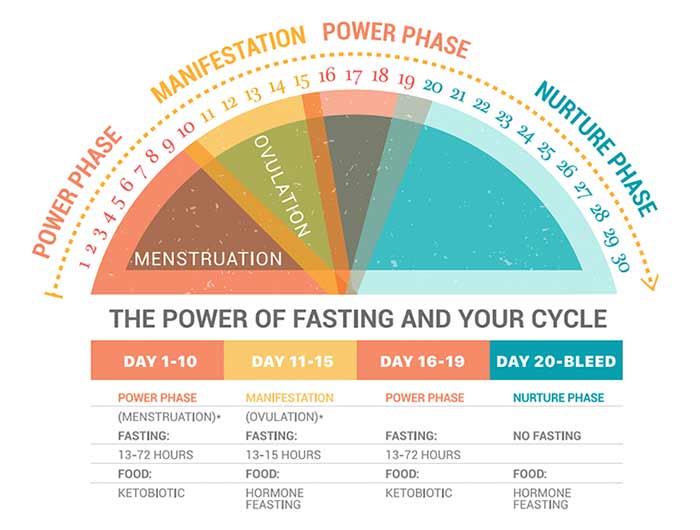
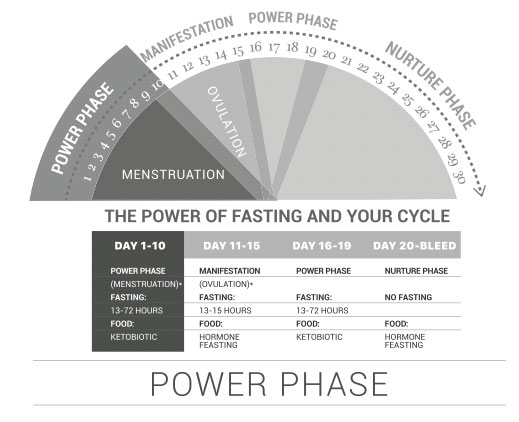
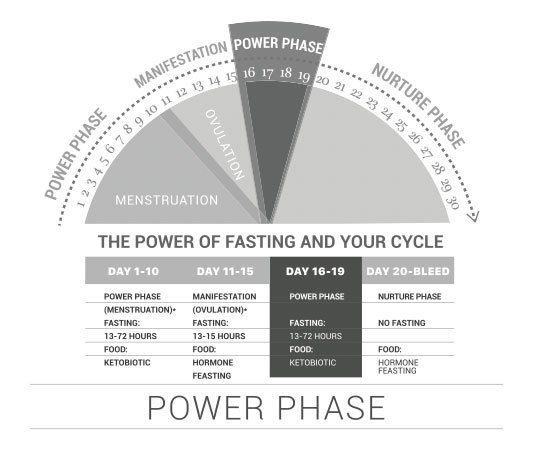
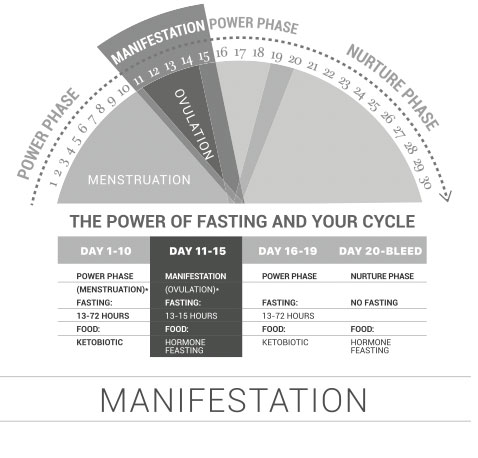
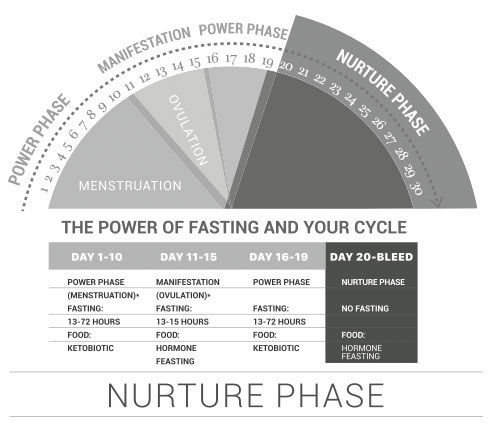
Fasting Cycle for Perimenopausal and Menopausal Women
If you no longer menstruate because of your age, this next section is for you:
"Around 40, you really need to start to get to know the characteristics of progesterone and estrogen, primarily because as your ovaries are going into retirement, you're going to see some pretty dramatic shifts in those two hormones …
If you're spotting, that's progesterone tapping you on the shoulder saying, ‘Hey, I need a little more glucose.’ So, you would step out of a keto fasting day, and the next day you may shorten your fast, elongate your eating window and use more of nature's carbs to give progesterone more glucose. So, spotting is a big one.
Anxiety is another big one. Trouble sleeping is another big one, where we need to have women step out of keto and fasting and step into more of this higher glucose [level, i.e., eat more, and expand your eating window]. Progesterone loves root vegetables, all the squashes, grass-fed beef, even tropical fruits. Bananas, mangoes, papayas, citrus fruits, those really help support progesterone production.
A perimenopausal woman will know that estrogen's really low when she starts getting hot flashes, when her hair starts getting frizzy and dry. When her skin is really dry, she's starting to get more wrinkles, her mucosal membranes become really dry and cognition is difficult.
If that's happening, then you actually want to lean into a little bit of the longer fast, because estrogen does really well with a longer fasting window, and you want to lean into more of a ketogenic diet. I think she still needs some carbs, but she really needs to lean into longer fast to get estrogen and more protein. And that will dramatically help."
If you’re in menopause, Pelz recommends doing the 30-day reset detailed in her book, but timed to the moon cycle. You may notice that the four cycles in the charts above have the same names as the moon cycles. So, you’d start your reset based on the moon cycle that is present at the time that you begin. For example, the day of the full moon is ovulation at Day 11, so you’d start at Day 11 and follow the schedule for the next 29.5 days from there.
More Information
To learn more, be sure to pick up a copy of "Fast Like a Girl." She’s also releasing an app that will guide you on what you should be doing each day, which can be a very helpful tool.
Comments
Post a Comment